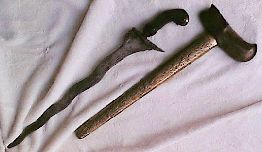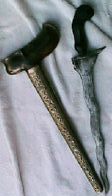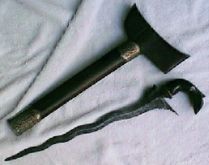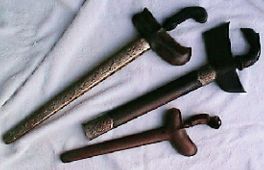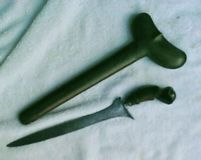originally published by Antiques Review in 1999 under the following pseudonym
The sinuous blade on display was definitely a Kris – the mystical and lethal, traditional weapon of the Malays. The stallholder in Needham Market issued a warning. “There are many copies and I can’t really tell, but I think it’s a good one”. ‘It’ was a beautiful example, in the sort of condition which told that it could have been a cosseted antique or a ceremonial wedding Kris preserved by a family proud of its tradition. The abundance of curios for sale from, and in South East Asia can be confusing. The casual buyer, seeing a poorly plated Kukri offered alongside a replica samurai sword, near a Bornean hilang or Malay kris might dismiss all, without further thought, daunted by the task of authentication.
Unlike most foreign daggers, the Malay hilt appears bent, to provide a four or five inch “pistol grip” facilitating its use as a thrusting weapon. Balinese or other Indonesian hilts are usually straight. The woodcarving represents Hindu deities. Local carvers work freehand on the hilt but the sheath, traditionally made from finely grained “ornamental wood”, is rarely carved. It will be polished and may be decorated with silver or ivory trim. There are relatively recent examples of ivory hilt, sheath and trim but these are usually modern “bridegroom ornaments” and they probably became popular with Asian carvers, due to the increased availability of African ivory. Amongst the historic weapons are regional variants where Arabic, Quranic quotations may be displayed on the blade. These were etched or engraved, then filled with silver. There is a smaller defensive kris, which has a curved (six inch), one-sided blade. Its name in Malay might remind you of the spurs of the fighting cocks – Lawi Ayam. It has been fascinating to meet a number of Malay ironsmiths in workshops as far apart as Trengannu and Brunei who still make a few ceremonial Kris for weddings and national display. All these craftsmen have a fund of ‘Kris’ stories, from those featuring the legendary Hang Tuah, to the more contemporary about ‘The Father of Malaysia’, Tungkhu Abdul Rahman. If you travel east, intent on buying in village markets, it would be worth learning some Malay language. Being able to discuss the history and mystery associated with the weapons will help your price and extend to you folklore, hospitality and, with luck, some of the mystery and fascination of the antique Kris.
©Michael Austine Wilfred Griffin 1999


Bone handled straight edged Kris (Early to mid 19th Century)


